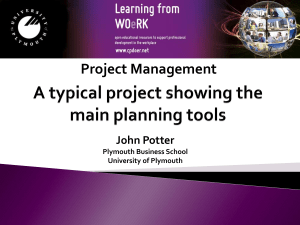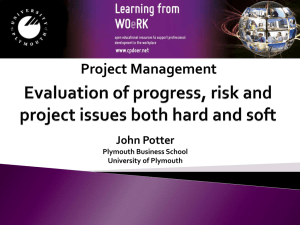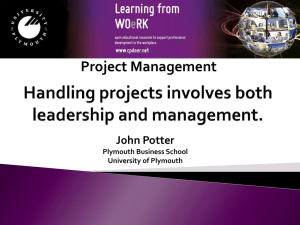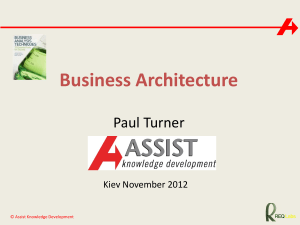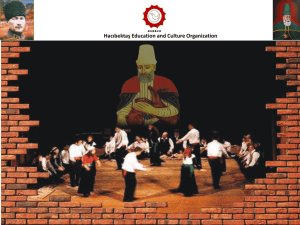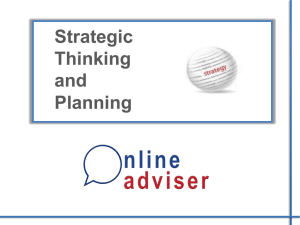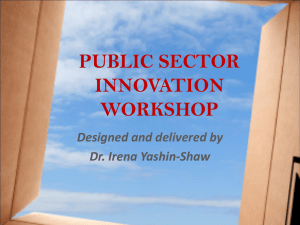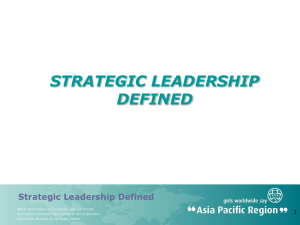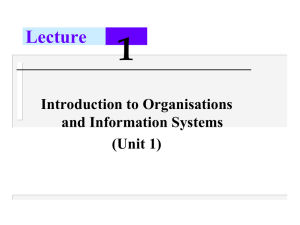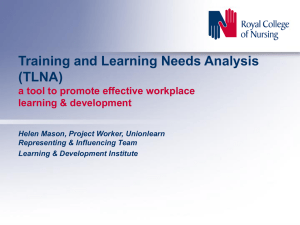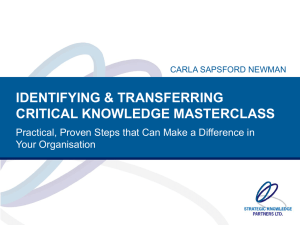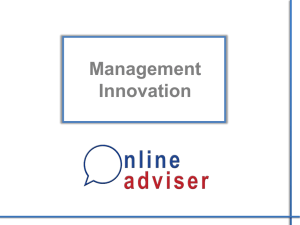What is a project
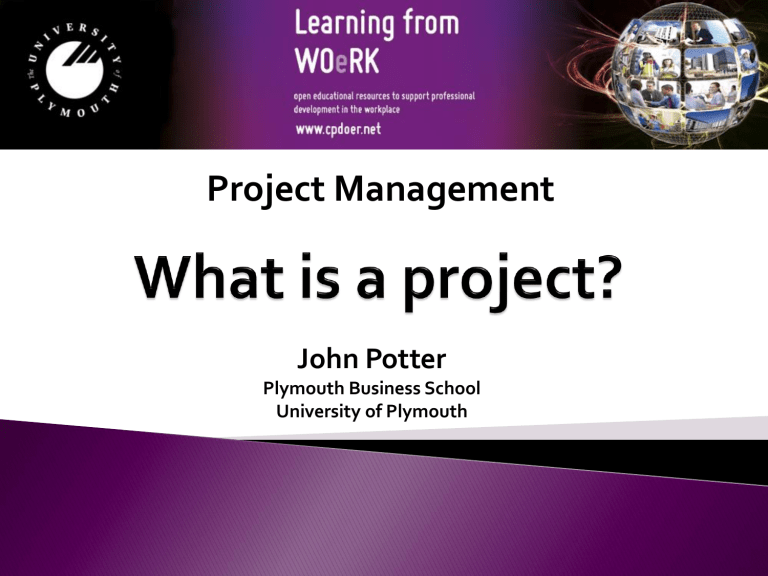
Project Management
John Potter
Plymouth Business School
University of Plymouth
The nature of project working
• Projects are efforts to achieve objectives
•Projects have a start, a middle and an end
•Thus projects are different from operational activities which are performed regularly over time e.g. payroll
•However, there can be some overlap between project management and operational management
•There are core skills involved in project management including identifying and agreeing on project objectives, scheduling and estimating
•In addition other issues such as managing risk, communication and dealing with other people are key areas of importance
A project can be defined as ……..
“……..and endeavour in which human (or machine), material and financial resources are organised in a novel way, to undertake a unique scope of work, or given specification, within constraints of cost and time, so as to deliver beneficial change by quantitative and qualitative objectives”
◦
Turner – The handbook of project-based management:
Improving the Process for Achieving Strategic Objectives
◦
Five functions of project based management:
◦
Organisation, scope, time, quality and cost.
Turner (1998) The handbook of project-based management: Improving the
Process for Achieving Strategic Objectives.
Overview of this module
• In this module we are going to consider a number of specific aspects of project management
•The shift away from a focus just on planning towards an increased awareness of the human issues
•We will be considering project leadership as well as project management, creating the project team and promoting organisational team working
•The processes of monitoring and evaluating the success of the project will be considered and the process of handing over the completed project.
The roots of project management
• The modern approach to project management may be traced back to the middle of the 20 th Century when the US Navy’s special Projects Office was formed in 1957 to support the nuclear submarine project.
•The PERT method (program evaluation and review technique) was established to analyse the tasks involved in completing a complex project
•A key feature of PERT is the identification of the critical path, that minimum amount of time that the project will consume given the various activities involved and how they relate to each other.
4
1 month
D
3 months
F
3 months
2 months
1 2
5
A E
B C
4 months
3 months
3
There are five milestones 1 to 5 and six activities A to F which are estimated to take 1,2,3 or 4 months as shown. The minimum time for project completion is the CRITICAL PATH of 7 months shown as a thick lines.
There are many types of project which we will identify later in this session
Whatever the nature of the project there are three core issues which need to be addressed:
◦
Quality
◦
Cost
◦
Time
In addition, projects invariably take place in a context which includes organizational politics, individuals’ personal objectives and external, commercial or stakeholder pressures.
Organisational politics
Personal
Objectives
Cost
Quality Time
Business
Pressures
External and stakeholder issues
Types of projects
• Originally project management techniques tended to be applied to large construction or defence projects.
• However many types of project exist
• Many new style projects exist which vary in size, length and complexity. They can include installing ICT systems, office moves, testing a new product, acquiring or merging with another organisation, an internal change programme and a host of other areas of work
• Whether in manufacturing, financial services, retail, the health service or local government there is usually one person, the project leader who is in charge
•During this module on project management we will be looking at the issue of effective project leadership.
A new definition of project management
•
In their book ‘Project Leadership’ Briner, Geddes and
Hastings propose a new definition of project management:
“new style project management is managing the visible and invisible team to achieve the objectives of the stakeholders”
The six concepts that underlie this idea are:
The visible team – those people working directly on the project, full time or part time
The invisible team – those people who contribute indirectly to the work of the visible team either inside or outside the organisation
The Multiple stakeholders – All those people having an interest in the project
In addition there are issues of organisational teamworking, organisational context and the people factor to consider
Understanding and handling the people factor
• Problems in project working are caused as much by people issues as by technical or resource issues
• Effective team work promoted by effective project leadership
• One of the sources of problems in project working is that technical people often have little experience or appetite for handling the people issues
•The accelerating rate of change
•Most organisations are struggling to cope with increasing regulation and risk of litigation, disaffected employees with low morale and complexity in general terms.
Project leadership is strategic and operational in nature as well as based on effective leadership
The three levels of strategic operational and front line leadership are as important in project leadership as in other circumstances
Strategic leadership is about creating the grand plan, focusing on the big picture and understanding the strategic fit of the project
Operational leadership is about putting the grand plan into practice and developing the day to day activity on the project
Team leadership is about outcomes required, time issues and specific boundaries
These three levels of leadership all take place within the culture of the organisation and its project organisation and both the project teams and the organisation as a whole needs to stay in touch with its environment, the business context in order to stay current in its thinking
We can see how these three levels of leadership, the culture and the context or environment relate in the next slide
Strategic
Operational
Environment.
Culture
Front Line
Becoming more strategic as a project manager
• Strategy is about the ‘big picture’
•It is important to create a vision to describe the situation which will exist when the project is completed
•Strategy is about looking outside the ‘box’ of your own project to consider how success or otherwise in the project will affect the organisation
•We all face uncertainty in terms of the future. A key element in strategic thinking in the modern world is the idea of scenario analysis.
Project evaluation – hard and soft measures
• Each project has detailed success criteria
•These are sets of specifications which the project has to meet
•Success factors vary
•They may be clearly defined or open such as defining a desirable output
•Hard criteria include meeting deadlines, performance specifications, quality standards, cost and resource issues
•Soft criteria may include a positive image, cooperative attitudes, commitment and ethical issues.
Managing stakeholder relationships
• We will conclude this session by considering some stakeholder issues
• Build a knowledge base about your stakeholders
•What is their background, history, status and predominant beliefs about the project?
•What sort of people are they?
•Do they have any negative assumptions about the project?
• How can you develop effective relationships with your most significant stakeholders?
References
Briner, W, Geddes, M, Hastings ,C (1990) Project Leadership. Gower:
Aldershot, England.
Turner.J.R. (1998) The handbook of project-based management: Improving the
Process for Achieving Strategic Objectives. McGraw-Hill: London
Lee-Kelley.L. & Leong, K.(2003) “Turner’s five-functions of project-based management and situation leadership in IT services projects”. International
Journal of Project Management (21:8) 583-591
Ringland, G. (2006) Scenario Planning .John Wiley & Sons: West Sussex, UK.
Text for audio
This resource was created by the University of Plymouth, Learning from WOeRk project. This project is funded by HEFCE as part of the HEA/JISC OER release programme.
This resource is licensed under the terms of the Attribution-Non-Commercial-Share Alike 2.0 UK: England
& Wales license ( http://creativecommons.org/licenses/by-nc-sa/2.0/uk/ ).
The resource, where specified below, contains other 3 rd party materials under their own licenses. The licenses and attributions are outlined below:
1.
The name of the University of Plymouth and its logos are unregistered trade marks of the University. The University reserves all rights to these items beyond their inclusion in these CC resources.
2.
The JISC logo, the and the logo of the Higher Education Academy are licensed under the terms of the Creative Commons Attribution
-non-commercial-No Derivative Works 2.0 UK England & Wales license. All reproductions must comply with the terms of that license.
Author
Institute
Title
Date Created
Educational Level
Keywords
John Potter
University of Plymouth
What is a Project
10/06/2011
Level 5
Learning from WOeRK Work Based Learning WBL Continuous
Professional Development CPD leadership and management UKOER
LFWOER
©University of Plymouth, 2010, some rights reserved
Back page originally developed by the OER phase 1 C-Change project

